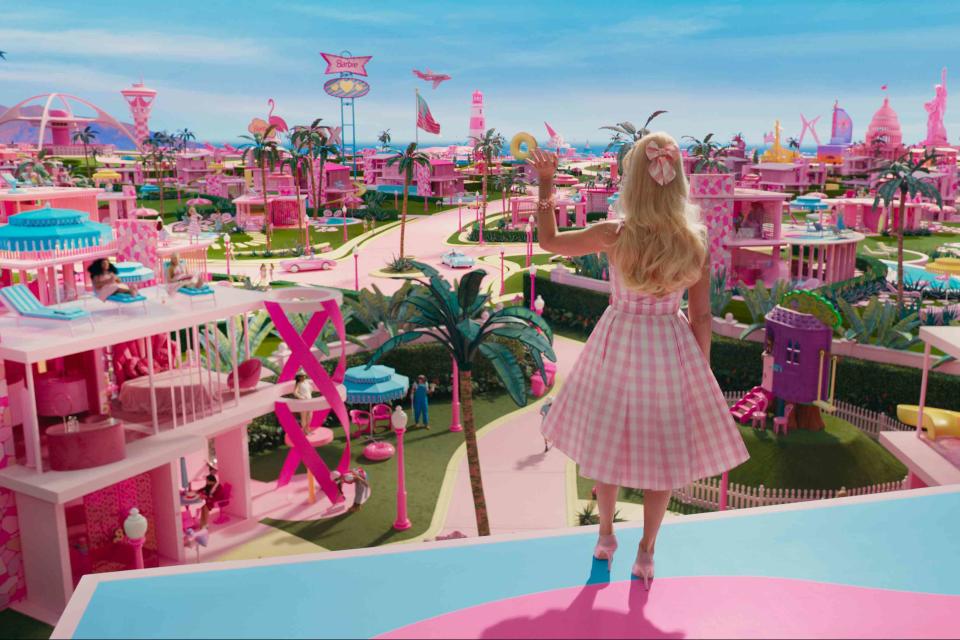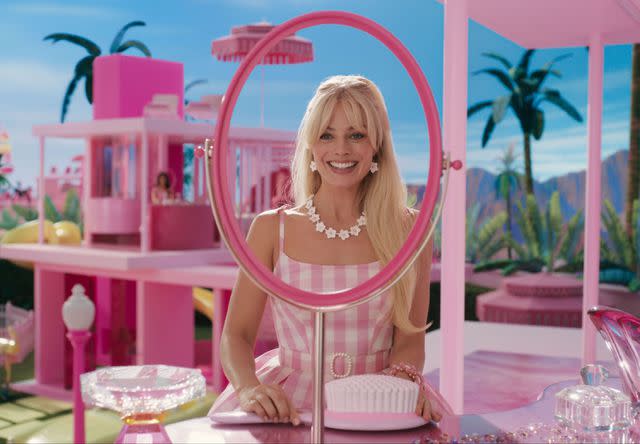Here's Why I'm Proudly Raising a Barbie Girl
With 'Barbie: The Movie' hitting theaters, the classic doll is bringing together generations of fans. One mom shares the impact the doll has made on her and her daughter.

Courtesy of Warner Bros. Pictures
My 8-year-old daughter and I are two Barbie girls living in a Barbie world—and I wouldn’t have it any other way.
Ever since the first teaser trailer for Barbie: The Movie dropped, we’ve counted down to the release, declaring the summer of 2023 as our “Summer of Barbie.” We kicked off Memorial Day weekend with a visit to the Malibu Barbie themed cafe in New York City, my daughter’s favorite Barbies (out of well over 100) have had many a birthday celebration at the beach, and the minute that tickets for the Barbie movie went on sale, we reserved a whole block for our large group of 12 friends—opening weekend, of course!
In between, we’ve shopped for all the Barbiecore merch we can get our hands on, including cosmetic cases, t-shirts, stickers, keychains, jewelry, tote bags, denim jackets, towels—even phone chargers. And, of course, the movie-inspired Barbies and Ken dolls—‘Margot Robbie’ Barbie and ‘Ryan Gosling’ Ken, as my daughter refers to them—are now in our collection.
As it turns out, my daughter and I are right on trend as we relish in the “Summer of Barbie.” Marketing expert Maggie Gallant, founder of PR and Marketing agency Superjuice, says it’s not just Barbie’s summer. “2023 is the ‘Year of Barbie’—proving Barbie’s longevity as the ultimate cultural icon," Gallant says. "Barbie will continue to represent our hopes and dreams and be at the forefront of the zeitgeist.”
Related: The Best Kids' Movies of 2023
Barbie's Been Bonding Generations for Over 60 Years

Warner Bros. Entertainment
Now, while my daughter’s excitement for Barbie: The Movie has reached a fever pitch, I take full responsibility for bringing it up a notch (or 12). I’ve told her over and over that she’s so lucky to be to be a kid when this movie is hitting theaters. But I’m just as lucky to be a Barbie-obsessed mom with a daughter to experience it with. My mom grew up playing with Barbie dolls and happily passed that tradition onto me and my younger sister. Barbie has been a beloved rite of passage and tradition in my family.
When I was pregnant and found out that I was having a girl, the first thing I bought wasn’t pink bows but a carefully curated collection of Barbie dolls. Since then, our playroom has exploded into a “Barbie World,” filled with every type of Barbie (from “Firefighter” to “Gymnast”) along with tons of Kens, Stacys, and Chelseas, a dream house, Corvette, helicopter, and even a cruise ship.
On any given day, Barbie goes to space, goes glamping, opens a hot new restaurant or enjoys a spa day right in our playroom. During Covid, one of my hobbies became scouring Ebay for beloved Barbie dolls and accessories from my own childhood. It’s been surreal watching my daughter play with my all time favorites from the ‘80s like the Barbie McDonalds, Barbie Workout Center, Barbie’s Dream Store and classic dolls like ‘Crystal’ Barbie or my all time favorite—’Day to Night’ Barbie.
In 1959, Ruth Handler created Barbie with the philosophy that through the doll, little girls could be anything they wanted to be.
Cindy Eagan, author of The Story of Barbie and The Woman Who Created Her, believes young people feel Barbie’s “excitement, adventure, possibility and positivity” when playing with the dolls, especially because the story of Barbie's origin is so incredibly empowering.
“The only real dolls that were available in the late 1950s were baby dolls because most women became stay-at-home moms instead of pursuing careers or different paths. Ruth Handler wanted young girls to be able to envision many options for their future lives so they could see what might uniquely fit them,” explains Eagan. “Barbie represented all that was possible. Astronaut Barbie, Ballerina Barbie, Happy Family Barbie, Paleontologist Barbie. Barbie's had over two hundred careers, and after 64 years, she continues to keep pushing ahead.”
Barbie Can Do Anything

Warner Bros.
Growing up as a child in the 80s, the term “self-care” wasn’t mainstream—oh, how I would’ve loved the “Breathe with Me” Barbie that my daughter meditates with today. But even back then, I was giving myself that much needed “me time” by surrounding myself with Barbie dolls. I created worlds where Barbie lived out my fantasies—one was a famous writer, with credits like Sweet Valley High and“The Babysitters Club—or played out scenes to help ease my fears and social anxiety. (Barbie had many slumber parties where she didn’t fit in or felt left out.)
While Barbie soothed my inner worries and built up my inner self, I never gave much thought to her blonde hair, blue eyes, tiny waist, killer wardrobe or hot boyfriend. In real life, encountering girls who looked like Barbie or appeared to “have it all” would’ve sent my insecurities spiraling. But my focus never lasered in on Barbie’s looks as much as her famous phrase “we girls can do anything.”
I’ve never worried that my own daughter might compare her appearance to Barbie. Beyond a comment about wanting a wardrobe and closet as vast as Barbie’s, my daughter’s focus has remained on the big, confident life that Barbie leads.
Reena B. Patel, a positive psychologist, and licensed educational board certified behavior analyst explains that Barbie dolls allow children the ability to have a pretend world—like they would with a princess such as Cinderella or Snow White. “A child is in control of their play with the voices of wardrobe, lifestyle, occupation, and more,” Patel says.
I’ve seen my daughter use Barbies to work through new things in her world—from bullies at school to dream weddings. My husband and I are happily married, but when my daughter came home asking about divorce upon discovering a few classmates had separated parents, suddenly her Chelsea doll was deciding whether to sleep at Barbie or Ken’s house. As Patel reinforces, “Barbie is a miniature version of real life—and imaginative play is an integral part of developmental play.”
Related: 5 Benefits of Pretend Play
Barbie at the Forefront of Inclusivity

Warner Bros.
I'm always baffled when I do encounter a parent who is anti-Barbie because they believe the dolls aren’t inclusive or promote anti-feminist views. I couldn’t disagree more.
It’s comforting to watch my daughter use Barbie to work through the natural ups, downs and insecurities of growing up. Especially in a world of social media and screen time, Barbie encourages children to proactively use their imagination sans a tablet.
“It's a positive and bonding experience when young people play Barbies together, creating their own worlds versus worlds—many of which are often frenetic and violent—that have already been created for them,” says Eagan, who also emphasizes how important it was to Ruth Handler that young people see and play with a doll who looked like them.
It’s a philosophy that’s still important today. My daughter is proud to have Barbies of various skin tones and ethnicities and will happily point out which ones resemble her classmates and friends.
Gallant says that Mattel (the toy company behind Barbie) has been at the forefront of inclusivity in Barbie’s evolution. “Mattel was debuting Barbie dolls with a wide array of skin tones as well as fashion sizes—years—and in some cases decades—before any other toy manufacturers,” says Gallant. “We know representation matters and during the most impressionable years when many kids are first introduced to Barbie, they can see themselves both physically and philosophically.”
Related: New Barbie With Down Syndrome Proves the Iconic Doll Is More Diverse Than Ever
I know I have limited time until my daughter naturally starts outgrowing Barbie and her playdates evolve into “hangouts” for talking about crushes or trying on makeup. But I’m 45-years-old and not only still in awe of Barbie—but I also feel indebted to her. Barbie helped me navigate crucial questions, such as “what do I want to be when I grow up?” Barbie eased my worries about making friends and fitting in. And Barbie gave me permission to dream big, work hard and enjoy the good things in life. All things Barbie is now instilling in my daughter.
I never stopped being a Barbie girl—and now I’m proudly raising one. I cherish every second that our playroom remains “Barbie World” but comforted knowing that this “Summer of Barbie” will live on in the bond it's created with my daughter. Going all in on Barbiecore has created core memories (and so many shopping trips) that we’ll never forget. And I can’t wait to see what Barbie’s achieved by the time my daughter bestows the tradition onto her own kids!
For more Parents news, make sure to sign up for our newsletter!
Read the original article on Parents.

